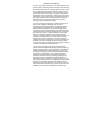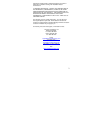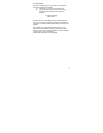
GB
P.4
GB
P.5
II. Start Up Sequence
A. Initial Start
1. Immediately after the batteries have been installed, the indoor weather station will
sound a "beep", and the LCD will completely light up for a brief moment.
2. All information will then appear in normal mode, with "12:00" as the default time and
"1.1" as the default date (2001 as the year).
3. "DCA" is the default city (Washington, DC, USA), with the sunrise, sunset, moonrise
and moonset times displayed for that city at that date.
4. The indoor temperature and humidity, and barometric air pressure (as 29.91 inHg
relative RH) will also be displayed.
5. There is a "satellite" icon that appears near the bottom of the LCD, to the right of the
"max" remote temperature-this icon informs the user that the indoor weather station is
looking for signals from the remote thermo/hygro sensor. Within five minutes the remote
temperature and humidity should be displayed-if not, remove batteries from all units
and repeat battery installation, the remote temperature sensor first, then the indoor
weather station.
B. WWVB Reception
1. Once the batteries are installed in the Weather Center, it will automatically search for
the WWVB signal. If it receives a good signal (which is unlikely during daylight hours in
most locations), the WWVB reception indicator (looks like a tower icon) will flash. The
indoor weather station requires five full minutes of good reception to successfully capture
the signal and set to the correct hour, minute, second, month, day and year. If the
signal reception is not successful within ten minutes, the signal search will be cancelled
and will automatically resume every two hours until the signal is successfully captured.
2. The signal is sent from Ft. Collins, Colorado only and is similar to an AM radio signal.
Atmospheric interferences such as storms, sunspots, and even sunlight will cause the
signal to not travel as far.
3. To maximize reception, place the indoor weather station in a window facing Colorado,
at least six feet from any electrical source (computers, televisions, refrigerators, etc.).
Do not move the indoor weather station while it is searching for the signal.
4. The time and date can be manually set. Once the signal is captured, it will override any
time and date set to the time zone selected.
5. Once the time and date are set, the indoor weather station will conduct a search every
night at midnight and correct to the accurate time and date (Daylight Saving Time is
automatic). If the signal has been received in the past 24 hours, the reception indicator
will be displayed.
REMOTE
THERMO-SENSOR
433 MHz
+
SIZE AA LR6
+
SIZE AA LR6
Rain
Cover
Thermo-Hygro
Transmitter
Mounting
Bracket/Recent
Battery
Cover
+
SIZE AA LR6
+
SIZE AA LR6
+
SIZE AA LR6
NOTE
: Fog and mist will not harm your remote thermo/hygro sensor but direct rain must be avoided.
To complete the set up of your indoor weather station after the 10 minutes have passed please follow
the steps in the Detailed Set Up Guide.
Note
: The remote thermo/hygro sensor transmits a signal every 5 minutes; after the batteries have
been installed, the indoor weather station will search for the signal for a duration of 5 minutes. If there
is no temperature reading in the OUTDOOR LCD after 5 minutes, make sure the units are within
range of each other, or repeat the battery installation procedure.
DETAILED SET-UP GUIDE
I. Battery Installation
Batteries will fit tightly. To avoid start-up problems, make sure that the batteries do not spring
free. Also be sure to insert alkaline batteries into the remote thermo/hygro sensor first, then
the indoor weather station. Initial set up should be done with the remote thermo/hygro sensor
and indoor weather station in the same room. The units should be permanently mounted only
after the signal reception has been verified.
A. Remote Temperature and Humidity Sensor, TX4U
1. Pull the cylindrical rain cover off the transmitter.
2. Remove the battery cover (located on the backside of the transmitter, above the
mounting post and bracket). Press the arrow and slide the battery cover off.
3. Observing the correct polarity install 2 Alkaline AA batteries.
4. Replace battery cover, and place rain cover snugly onto the transmitter.
B. Weather Center
1. Remove the battery cover (the cover has white writing on it).
2. Observe the correct polarity, and install three Alkaline AA batteries.
3. Do not press any buttons for at least ten minutes. If a button is pressed before the
Weather Center has received information from the TX4U sensor, no data will be received
from that sensor until reset.
4. Replace the battery cover.


















